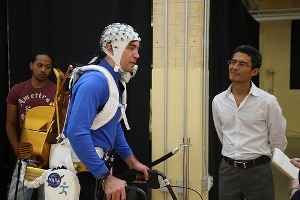Sep 19 2013
Jose Luis Contreras-Vidal looked on as Roger Rovekamp, wearing a skullcap covered in electrodes, took halting steps, each leg moved by the robotic exoskeleton wrapped around his body.
 Robotics engineer Roger Rovekamp tries out the X1 exoskeleton as UH professor Jose Luis Contreras-Vidal looks on.
Robotics engineer Roger Rovekamp tries out the X1 exoskeleton as UH professor Jose Luis Contreras-Vidal looks on.
Contreras-Vidal, a professor of electrical and computer engineering at the University of Houston Cullen College of Engineering, develops algorithms that read electrical activity in the brain and translate it into movement.
His Rehab Rex gained attention for its ability to help people with spinal cord injuries stand upright and “walk.” That project is now waiting for clinical testing to begin at Houston Methodist Hospital.
His newest project is a colaboration with engineers from NASA, and it could help patients with conditions such as stroke or Parkinson’s disease.
Contreras-Vidal said at least some of those patients would use the robot only temporarily, as a rehabilitation tool.
Rovekamp, a robotics engineer with Oceaneering Space Systems, recently served as a test subject on the new project. He said NASA wants to address the muscle atrophy and other health risks astronauts might face during long-duration space travel.
The X1exoskeleton was jointly designed by NASA and the Florida Institute for Human and Machine Cognition in Pensacola, Fla.
NASA is interested in its potential as an exercise tool for crew members, both at the International Space Station and on future long-duration space flights, and Contreras-Vidal said the X1 also could have the ability to measure and send data back to flight controllers, providing information on how the flight is affecting their health.
But much of his research is focused on the exoskeleton’s potential for use in physical therapy. The X1 is smaller than the Rehab Rex and could help people recover from a brain injury by teaching the brain to re-wire itself, he said.
The brain-machine interface, or BMI, technology works by interpreting brain waves that allow patients to control the robotic legs with their thoughts. It can control the user’s movements, through motorized joints at the hips and knees, or simply provide some resistance, depending on how it is programmed, he said.
Contreras-Vidal and his research team record brain signals using a scalp electroencephalogram, or EEG, through a skull cap fitted with electrode sensors. That avoids the need for implanting electrodes under a patient’s scalp.
The electrodes also can measure brain activity to ensure the patient is actively mentally engaged in the rehab, he said. That’s important, “because you want to eventually get rid of the robot. You want to retrain the brain, so the patient has to be actively engaged.”